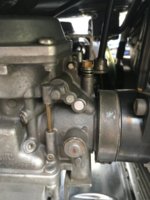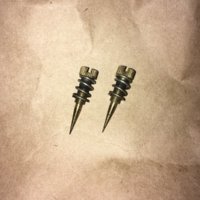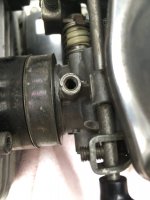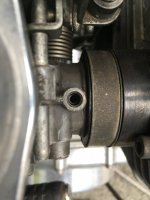Hello everyone,
I already posted some novice questions, but let me introduce myself again:
my name is Eduard and I have bought my Yamaha XS400 2A2 79 last year just before winter. I took it out last week and had few rides around the town ( I live in Prague, Czech Republic ).
As it is my first bike please pardon me for the obviously beginner questions ( and my imperfect English aswell ).
I have an issue with the Idle RPM - when I start the bike on full choke it goes to around 5000-6000 RPM
( I searched the forums and found that it should be around 3k? ), then on half choke it goes to around 3000-3500 RPM, without choke the RPM is too low and it would eventually die ( if I won't turn the throttle a bit ). So I found out about this throttle stop screw and with it I adjust the RPM ( by rotating clockwise) so it is just right ( 1200 - 1500 RPM ). However if I ride a little bit ( about 10 minutes ) and the engine warms up, causing the idle RPM to jump to about 3000. So I have to adjust the Throttle stop screw back to get the RPM normal again. Is this normal? How long should I leave the bike on full - choke and half - choke to warm it up? Could I ride for few minutes on half - choke until it gets warmed up?
I searched the forums and found what looks like a similar problem here: http://www.xs400.com/threads/tips-on-setting-idle-screw-correctly.11048/#post-114664 but the images posted by Hough aren't there anymore.
If I understand it correctly I should do what is said about Idle mixture screws? ( Please could someone confirm that this copper head screw at the picture is Idle mix screw? And is it symmetrical on both carburetors? )
I also found a lot of mentions about Idle speed screw, which I can't find in the manual. Is it just a different terminology for Throttle stop screw? If not please where can I find it?
Thank you very much and have a nice evening.
Ed
I already posted some novice questions, but let me introduce myself again:
my name is Eduard and I have bought my Yamaha XS400 2A2 79 last year just before winter. I took it out last week and had few rides around the town ( I live in Prague, Czech Republic ).
As it is my first bike please pardon me for the obviously beginner questions ( and my imperfect English aswell ).
I have an issue with the Idle RPM - when I start the bike on full choke it goes to around 5000-6000 RPM
( I searched the forums and found that it should be around 3k? ), then on half choke it goes to around 3000-3500 RPM, without choke the RPM is too low and it would eventually die ( if I won't turn the throttle a bit ). So I found out about this throttle stop screw and with it I adjust the RPM ( by rotating clockwise) so it is just right ( 1200 - 1500 RPM ). However if I ride a little bit ( about 10 minutes ) and the engine warms up, causing the idle RPM to jump to about 3000. So I have to adjust the Throttle stop screw back to get the RPM normal again. Is this normal? How long should I leave the bike on full - choke and half - choke to warm it up? Could I ride for few minutes on half - choke until it gets warmed up?
I searched the forums and found what looks like a similar problem here: http://www.xs400.com/threads/tips-on-setting-idle-screw-correctly.11048/#post-114664 but the images posted by Hough aren't there anymore.
If I understand it correctly I should do what is said about Idle mixture screws? ( Please could someone confirm that this copper head screw at the picture is Idle mix screw? And is it symmetrical on both carburetors? )
I also found a lot of mentions about Idle speed screw, which I can't find in the manual. Is it just a different terminology for Throttle stop screw? If not please where can I find it?
Thank you very much and have a nice evening.
Ed





